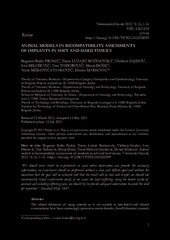Приказ основних података о документу
Animal models in bicompatibility assessments of implants in soft and hard tissues
| dc.creator | Prokić, Bolka Bogomir | |
| dc.creator | Lužajić Božinovski, Tijana | |
| dc.creator | Gajdov, Vladimir | |
| dc.creator | Milošević, Ivan | |
| dc.creator | Todorović, Vera | |
| dc.creator | Đošić, Marija | |
| dc.creator | Mišković-Stanković, Vesna | |
| dc.creator | Markovic, Danica | |
| dc.date.accessioned | 2022-05-23T08:26:41Z | |
| dc.date.available | 2022-05-23T08:26:41Z | |
| dc.date.issued | 2022 | |
| dc.identifier.issn | 2406-0771 | |
| dc.identifier.uri | https://vet-erinar.vet.bg.ac.rs/handle/123456789/2456 | |
| dc.description.abstract | The ethical dilemmas of using animals as in vivo models in preclinical and clinical examinations have been increasingly present in recent decades. Small laboratory animals (rats, rabbits) will continue to be used because they are cost-effective and permit the formation of statistically testable cohort groups; a task that, for financial, maintenance and care reasons, is almost prohibitive for larger animals. Technological advances in the production of new biomaterials for clinical use are enormous, but screening tests and methods used to assess biocompatibility lag behind these advances. The assessment of biological responses is slow and based on millennial recovery mechanisms in eukaryotic organisms. Therefore, the goal of researchers in this field is to re-evaluate old methods of biocompatibility assessment and introduce new methods of evaluation, especially for in vivo testing. In that sense, a revision of the ISO standards was planned and conducted in 2017, which insisted on cytotoxicity testing in cell lines and produced concrete proposals on how biocompatibility should be quantified. In vivo biocompatibility evaluation of biomaterials used for soft tissue recovery commonly utilises rats. Rabbits are recommended for implants used for hard tissues, because of the rabbit’s size, the possibility of implanting the biomaterials on a larger bone surface, and because of the peculiarities of rabbit bone tissue that favours rapid recovery after bone defects and enables easy reading of the results. | |
| dc.language | en | |
| dc.publisher | Faculty of Veterinary Medicine, Belgrade University | |
| dc.relation | info:eu-repo/grantAgreement/MESTD/inst-2020/200143/RS// | |
| dc.rights | openAccess | |
| dc.rights.uri | https://creativecommons.org/licenses/by/4.0/ | |
| dc.source | Veterinarski Glasnik | |
| dc.subject | subcutis | |
| dc.subject | biocompatibility | |
| dc.subject | bone | |
| dc.subject | rabbit | |
| dc.subject | rat | |
| dc.title | Animal models in bicompatibility assessments of implants in soft and hard tissues | |
| dc.type | article | en |
| dc.rights.license | BY | |
| dc.citation.volume | 76 | |
| dc.citation.issue | 1 | |
| dc.identifier.doi | 10.2298/VETGL210322005P | |
| dc.identifier.scopus | 2-s2.0-85116479356 | |
| dc.identifier.fulltext | http://veterinar.vet.bg.ac.rs/bitstream/id/6902/188-Manuscript-5038-1-10-20220422.pdf | |
| dc.type.version | publishedVersion |

